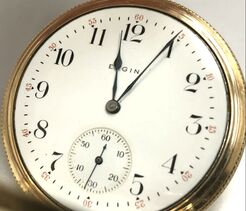Dial Materials
|
METAL
|
Metal is one of the two most common materials used on pocket watch dials. It is a thin piece of metal, usually painted with numeric hour markers and sometimes other, more elaborate details. Some dials were engraved and embellished with hand-chased designs. Antique and vintage dials will oftentimes become oxidized. Some collectors choose to have these dials refinished, or repainted, while others choose to leave them all-original. |
|
ENAMEL
|
The other common material used on pocket watch dials is metal coated with enamel (not porcelain or ceramic). Enamel dials (a.k.a. porcelain-enamel dials) are often mislabeled as porcelain. Porcelain is made from firing Kaolin to produce a hard, translucent pottery. Enamel is made from firing ground enamel powder (essentially ground glass) onto a metal backing. Once fired, the enamel is then polished and painted with any desired detailing. It is then fired again, producing an attractive, finished dial. These dials can be referred to as either porcelain-enamel, or just enamel, dials. Enamel dials are a labor-intensive process that are an art in itself. Enamel can chip, crack, or craze. Fine antique and vintage dials are sought after by collectors and should be preserved. |
Crystal Types
SAPPHIRE CRYSTAL |
Synthetic sapphire crystals, made via the flame fusion process, are the most durable, and scratch resistant, watch crystals to date. |
All photos courtesy of Scott Papper, GIA GG, AJP, CMA (NAJA)


















